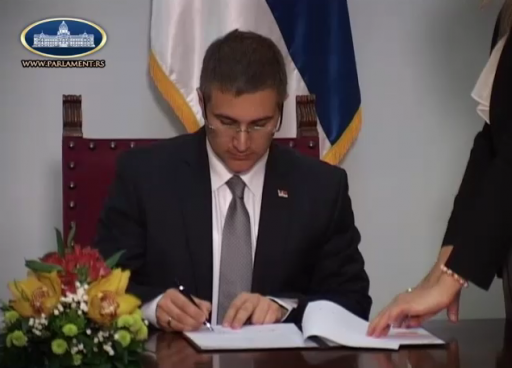The Archive of Serbia (the national archive of Serbia) and the National Assembly of the Republic of Serbia launched the first in a series of exhibitions on documents from the history of the modern Serbian state in November 2013.
The Serbia: Endurance and Memory exhibition was opened on the 12th November and presented primary sources from the country’s recent past – namely the First World War.
More exhibitions are planned throughout the year 2014.
National Assembly Speaker, Dr. Menjsa Stefanovic and the Director of the Archive of Serbia, Dr. Miroslav Perisic, opened the exhibition before signing a ‘Protocol of Cooperation’ to be enacted as the Centenary approaches.
Both Dr. Stefanovic and Dr. Perisic argued that ‘blame’ assigned to Serbia for causing the First World War – through the assassination of Archduke Franz Ferdinand – is unjustified, with Dr. Perisic decrying the “partial and unsubstantiated thesis on Serbia’s First World War guilt”.
“100 times repeated lie”
The Speaker of the National Assembly said that the primary sources relating to the First World War on display at the exhibition were “open and transparent and available to all those who are coming today to the House to interpret”.
Dr. Stefanovic continued that it was important for researchers and historians to “approach history without prejudice” and with the aim of “making our lives and lives of future generations better, without fallacies or misapprehensions”.
“The commemoration of the 100 year anniversary of the First World War is perhaps the best example that illustrates why historical resources are important in times when, more often than not, history is interpreted, or there are attempts to interpret history, in accordance with political goals”.
Adopting an approach “without prejudice” or “political goals”, Dr. Stefanovic said, is “the only way that we can prevent a 100 times repeated lie from becoming the truth”.
“Unsubstantiated thesis on Serbia’s guilt”
The Director of the Archive of Serbia, Dr. Perisic, described Serbia’s archives as “keepers of our memory, heritage and our identity, as well as a source of our historical knowledge”.
He said that the Serbia: Endurance and Memory exhibition, and the exhibitions which are to follow in 2014, are designed to “raise awareness” amongst the public about the First World War and its causes.
Dr. Perisic described Serbia as both a symbol of the victims and the victors of the conflict.
The Director was critical of “historians and other pundits from around the world who are receiving undeserved media coverage despite their unscientific books and papers that speak of Serbia’s guilt for the outbreak of the First World War, [and] have not even consulted the archives of Serbia”.
“It illustrates how partial and scientifically unsubstantiated their thesis on Serbia’s First World War guilt is. None of them have presented even one primary historical source that would support these positions”.
Through planned exhibitions, Dr. Perisic said the Archive of Serbia “will present to the public those primary historical sources without which it is not possible to interpret and understand events that occurred in 1914 and during the First World War. I am quite certain that some of these documents will stir some new international debates amongst historians and transfer [the discussion] back to a scientific framework”.
Dr. Perisic concluded by warning that “history is dangerous if it is not understood properly” and that the Archive of Serbia, National Assembly and Ministry of Culture and Information are trying to “make it less dangerous”.
He stated that “the documents we are presenting are very powerful and they can tear down those interpretations that are not granted”.
Source: Serbian Government press release
Images courtesy of the Serbian Government
Posted by: Daniel Barry, Centenary News
